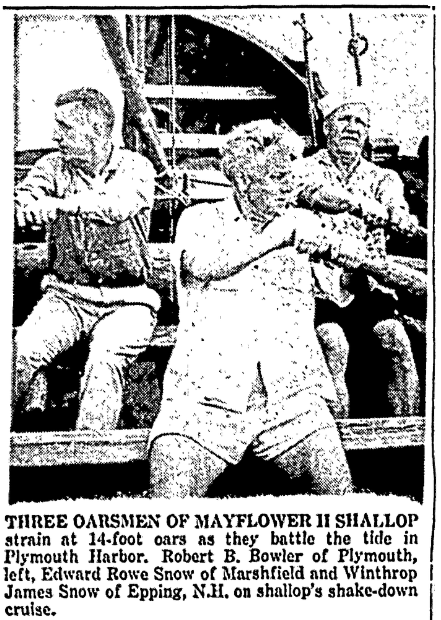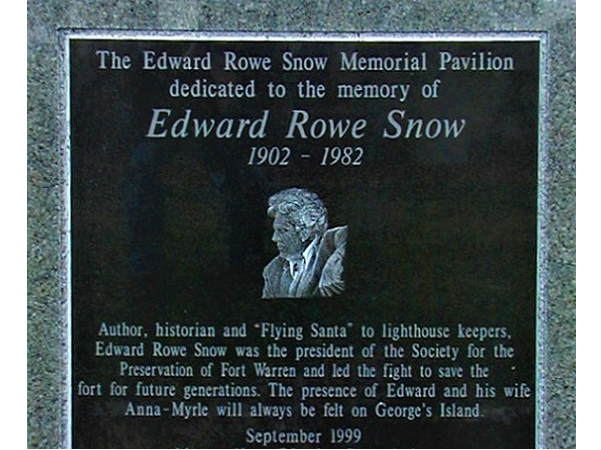Introduction: In this article, Melissa Davenport Berry continues her series on Mayflower descendants, focusing on author and historian Edward Rowe Snow. Melissa is a genealogist who has a blog, AnceStory Archives, and a Facebook group, New England Family Genealogy and History.
Today I continue with my series “Mayflower Descendants: Who’s Who” with a focus on Edward Rowe Snow (1902-1982), author, historian, and famous “Flying Santa.” Rowe is a descendant of Mayflower passenger Stephen Hopkins. He also has ancestors who qualify him for the Jamestowne Society.
Snow left a treasure trove of over 100 historical publications on New England; plus, he had a daily newspaper column that covered subjects from Pilgrims to Puritans to pirates. He was an active participant in historical preservation and noted as a great lecturer and treasure hunter. Here are his stories.
In 1958 the Patriot Ledger published this photo of Snow in action, helping to row a replica of the Mayflower’s shallop (a “33-foot rowing-sailing craft”) on its maiden voyage in Plymouth Harbor. The original Mayflower had a shallop stowed aboard which the Pilgrims used to explore the Cape Cod coastline once they had arrived in 1620.

The article accompanying this photo noted there were six men in the shallop’s crew, and all but one descended from Mayflower passengers:
With the one exception of Frank A. Davis Sr., every member of the crew yesterday was a Mayflower descendant. George A. Davis, who is captain of the Mayflower II, and 15-year-old Arthur Lacey both came from the Brewster clan, while Edward Rowe Snow and Winthrop J. Snow are from the Hopkins and Alden ancestry. Robert B. Bowler is a Howland.
According to the article, Snow and the other Pilgrim scions planned to duplicate the Thompson’s Island trip made by Capt. Miles Standish in 1621. The original Mayflower’s shallop was shipwrecked off Manomet Point near the Mary Ann Rocks, which caught the Robert E. Lee in 1928.
In 1965 a plaque to honor Christopher Jones, the Mayflower captain who carried the Pilgrims across the Atlantic, was unveiled – and Snow was front and center of this event. He is featured in this photo with Arthur J. Cunningham, president of the Massachusetts Marine Historical League.
The plaque reads:
“The Jones River which flows by this site is named for Captain Christopher Jones of the Mayflower. On the banks of this Kingston River 276 vessels were launched between 1775 and 1887.”
The Jones River, which flows near the Major John Bradford House, has a long history. The timing for this event unveiling the plaque was in conjunction with Capt. Jones’ 400th birthday, and Snow gave a lecture on the history as well as a tour of the Bradford House.
After Snow’s talk that night, the interest in Captain Jones grew, and Snow published more on the captain in his column “Sea and Shore Gleanings” in the Patriot Ledger.
This article reported:
Capt. Christopher Jones was born in England in 1565, working his way to captain by 1615. He went aboard the Mayflower as master in 1620.
The good ship, packed to the gunwales, made satisfactory progress under the careful guidance of Captain Jones.
Indeed Jones was a hard, rough sea dog, but under the so-called “quarter deck manner” he was a reasonable and kind man. The fact is he was much more humane than many other masters of his day.
The Mayflower continued across the Atlantic, and Captain Jones sighted land on Nov. 10 at dawn. They were actually off the wrist of Cape Cod near the high bluffs of Truro.
That morning Captain Jones called the leaders together. They announced that they were anxious to go to “some place” near “Hudson’s River.” Therefore Captain Jones continued following a southerly course until the Mayflower reached a point probably off Chatham, where “dangerous shoals and roaring breakers” lay ahead. This area was actually the famous Tucker’s Terror, named by Capt. Bartholomew Gosnold in 1602 when he encountered them.
Captain Jones now ordered the helm put hard over and by nightfall they were sailing northerly and back in a relatively calm area. That night the Mayflower lay to in the open sea.
Early the next morning, 66 days out of Plymouth, England, the Pilgrims rounded the curved tip of the Cape into what is now Provincetown Harbor, a beautiful vista offering the Pilgrims at least temporarily contentment.
When the anchor chain rattled down out of the hawse pipe, one might think all would be happiness, but actually this was the moment when mutiny developed on the Mayflower. Quoting from the records, “affairs had taken an ominous turn.” There were many aboard who were not pleased with the way matters were going. It was brought out that the patent they had was for Virginia and not New England, which belonged to another government “with which ye Virginia Company had nothing to doe.”
The malcontents announced that when they went ashore they would “use their own labor for none had power to command them.” Of course, I must admit that my own ancestor, Stephen Hopkins, whose daughter, Constance, married Nicholas Snow several years later, had been in very serious trouble at Bermuda in 1609.
To meet the situation the leaders decided to draft a document. Probably Brewster worded it, but as soon as it was finished everyone was called to hear it slowly read aloud.
This is known as the Mayflower Compact.
To be continued…
Explore over 330 years of newspapers and historical records in GenealogyBank. Discover your family story! Start a 7-Day Free Trial.
Note on the header image: Edward Rowe Snow Memorial Plaque on Georges Island in Boston Harbor. The inscription reads: Author, historian, and “Flying Santa” to lighthouse keepers. Edward Rowe Snow was the president of Society for the Preservation of Fort Warren and led the fight to save the fort for future generations. The presence of Edward and his wife Anna-Myrle will always be felt on George’s Island.
Related Article:
